One of my all-time favorite phones is the Honor 8, originally released almost ten years ago. Back then, the gulf between a flagship and budget phone was so vast that when OnePlus and Honor stormed the European market, it actually changed the way consumers looked at the value proposition of what they were offered.
At the time, Honor 8 offered basically everything the high-end Galaxy S7, only at lesser cost. Sure, you had to deal with some compromise, and the UI back then wasn't the most intuitive. But for over four years, the Honor 8 was my go-to device, and it changed the way I approached most technology since then. Even today, my first thought with everything I daily drive is to ask: "Do I need the more expensive option?"

Fast forward to 2025, and the market sees the arrival of the Honor 400, a mid-range model that sits between its siblings, the 200 and the 400 Pro, as a mostly polished experience that proves you don't need to break the bank to get a device that feels like a flagship.
I've spent a month with this device, and the most surprising thing about using the Honor 400 is how rarely I've even thought about – let alone needed – a more expensive phone. Don't get me wrong, there are still compromises; but they are fewer and further between than you'd imagine.
Read on to discover how the Honor 400 works as a content creation device and, most importantly, how accessible it is for an autistic user who demands quite a bit from their smartphone.
The most surprising thing about using the Honor 400 is how rarely I've even thought about – let alone needed – a more expensive phone.
Specs and design
In Finland, the Honor 400 comes only in one configuration, which is the 512GB storage and 8GB RAM combo. It starts at €449, though you'll already find it cheaper at the time of writing. It sits in the lower mid-range in terms of cost, but delivers a user experience of phones at least twice its asking price. The ample storage space, for one, makes the competition's 128GB offerings look downright laughable.
The Honor 400 is a mid-sized phone with a 6.55-inch AMOLED panel that boasts 10-bit color and a whopping 460 pixels per inch sharpness. What this means is that it's a joy to read and consume media on this device. There is a small punch-out hole for the face scanner and camera, which also works as a digital island, similar to the one seen on iPhone's.
The screen is flat with no rounded edges, and I can't emphasize enough how happy I am with that. The rounded edges craze is awful for people like myself, who have cognitive disabilities and struggle to grasp the device without causing phantom touches to the sides. Thanks to the grippy and sturdy sides, the Honor 400 is always a joy to use. It feels like it was designed with practicality in mind, which makes it stand out from all other devices in the best kind of way.
There is an optical fingerprint reader, which is located a little too low for my personal taste, but it's nothing that you won't get used to after a few uses. I did find that the screen is prone to accidental touches quite easily, even when it was just in my pocket, which was annoying, but not a deal breaker.
The finger print scanner is fast and reliable throughout
Honor says their display has a peak brightness of 5000 nits. I don't measure these with lab equipment, as that's not the use case for the vast majority of users. For me, the phone simply has to be bright enough to work in direct sunlight and not have the dreaded rainbow effect when used with sunglasses.
In daily use, I haven't noticed any issues with this display. It is vibrant and gorgeous, and extremely comfortable to use in normal errands. This summer had some extremely harsh sunlight in Finland, which means numerous days where I worried I couldn't see the screen without cover. To my surprise, the screen was always legible and I didn't notice any major detriments to the battery life.
The Honor 400 has an aluminium frame with a glass back that is surprisingly resistant to fingerprints and scratching. It is IP65 rated, which means that small amounts of water or dust won't harm it, but I wouldn't take it swimming or into the shower. Buttons are tactile and easy to find, as there hasn't been any major changes to this design language in the last decade.
Superficially and on a quick glance, the Honor 400 looks quite a bit like the iPhone 16, and during my time with it I've had a handful of people off-hand remark that an app or something is available for my iPhone. If that's the kind of reaction you're going for, the Honor 400 will do just fine.
For me, I miss the days when Honor stood out on its own terms. The Honor 8, which I mentioned earlier, is still one of the prettiest phones out there. The Honor 400, make no mistake, is lovely to look at and feels great in the hand, but the design language is very safe and traditional. That's just the world we live in now.
Gripes aside, the Honor 400 looks and feels like a premium device. Like most other things about the device, it punches well above its class in every external aspect.
Honor 400 looks and feels like a premium device. It feels like it was designed with practicality in mind, which makes it stand out from all other devices in the best kind of way.
Screen accessibility
Here's one of the key areas where the Honor 400 really shines. No matter the price point, the Honor 400 has some of the most exceptional and terrific accessibility settings built into the monitor.
The screen resolution is 2736 x 1264, but there is a setting for "smart resolution", which is turned on by default. This means the phone automatically detects the optimal resolution for whatever app you're using, thus increasing battery life by not rendering something at a more power hungry level when it isn't necessary.
Spec-wise, the screen has a 120hz Free Refresh Rate, which is dynamic and can scale down to just 1hz when you're reading or using an app that doesn't require the high refresh rate. It has both Netflix and Amazon HDR certification, meaning that shows and films really look the best they can on a mobile device. You can even apply an AI Vivid assist on the videos, but I found this to be too artificial for my liking.
Similarly, I'm thrilled at the work Honor has put in with regards to their accessibility, eye comfort, and health. Today, we spend so much of our time with our electronic devices, I'm glad that anyone cares enough to try and figure out ways to make it even a tad bit better.
For example, the video enhancer allows for a Super Dynamic Display to up the brightness of whatever you're watching. The Circadian Night Display adjusts the screen colour temperature to sleep cycles, which, for me, is a lifesaver. I have erratic sleeping patterns on a good day, and the bright light of an OLED panel isn't exactly the best option for my eyes at three in the morning.
Likewise, the blue light filter, which you can adjust to meet your schedules, has been incredible when I'm on the road or troubled by insomnia.
There's also an option to turn on an E-reader mode, which makes the entire display into greyscale, another handy feature that shows that Honor's "try everything" mantra works more often than it doesn't.
For optical health and mental wellbeing, I've yet to find a device that has felt as comprehensive or inclusive as this one.
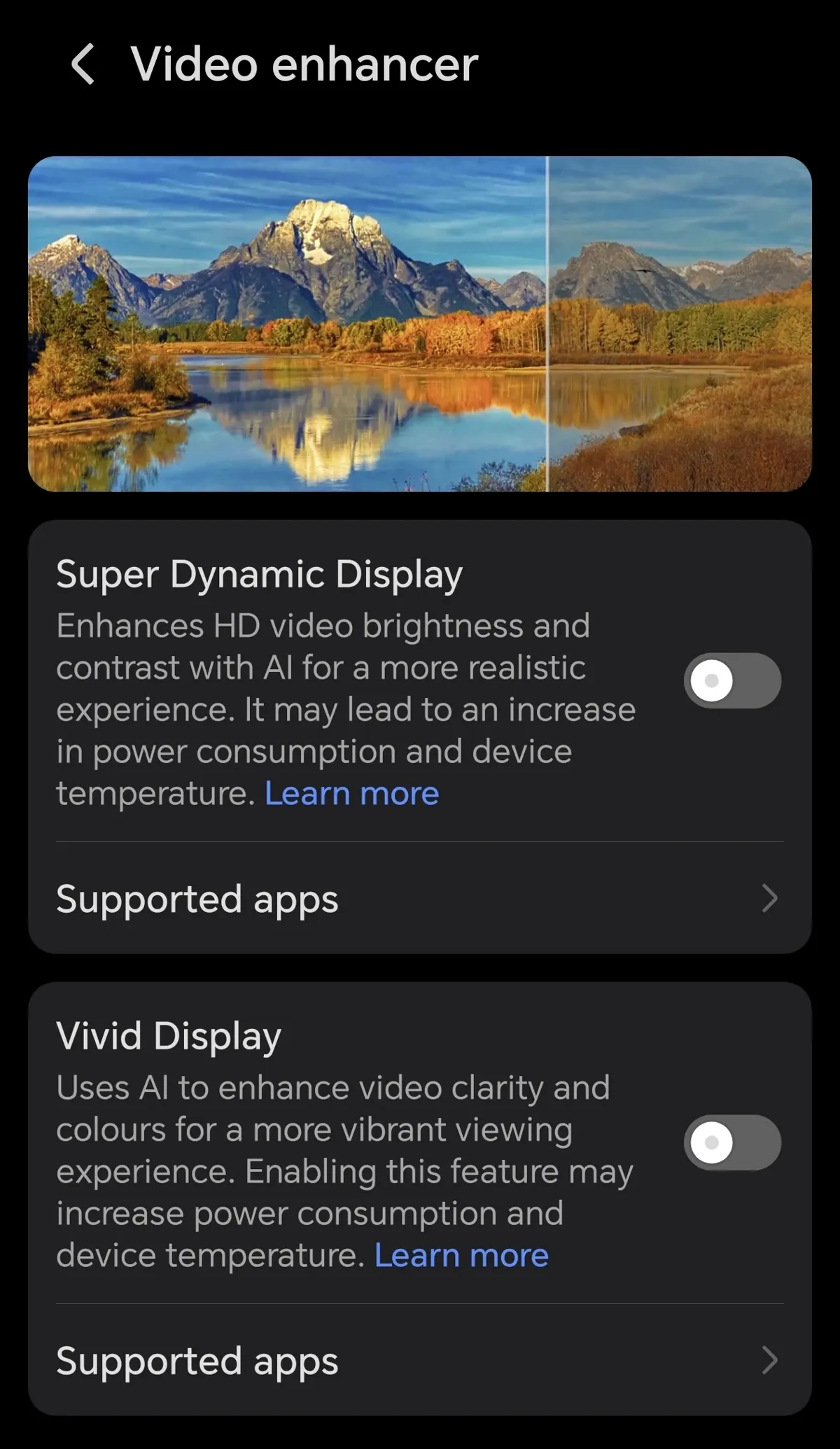
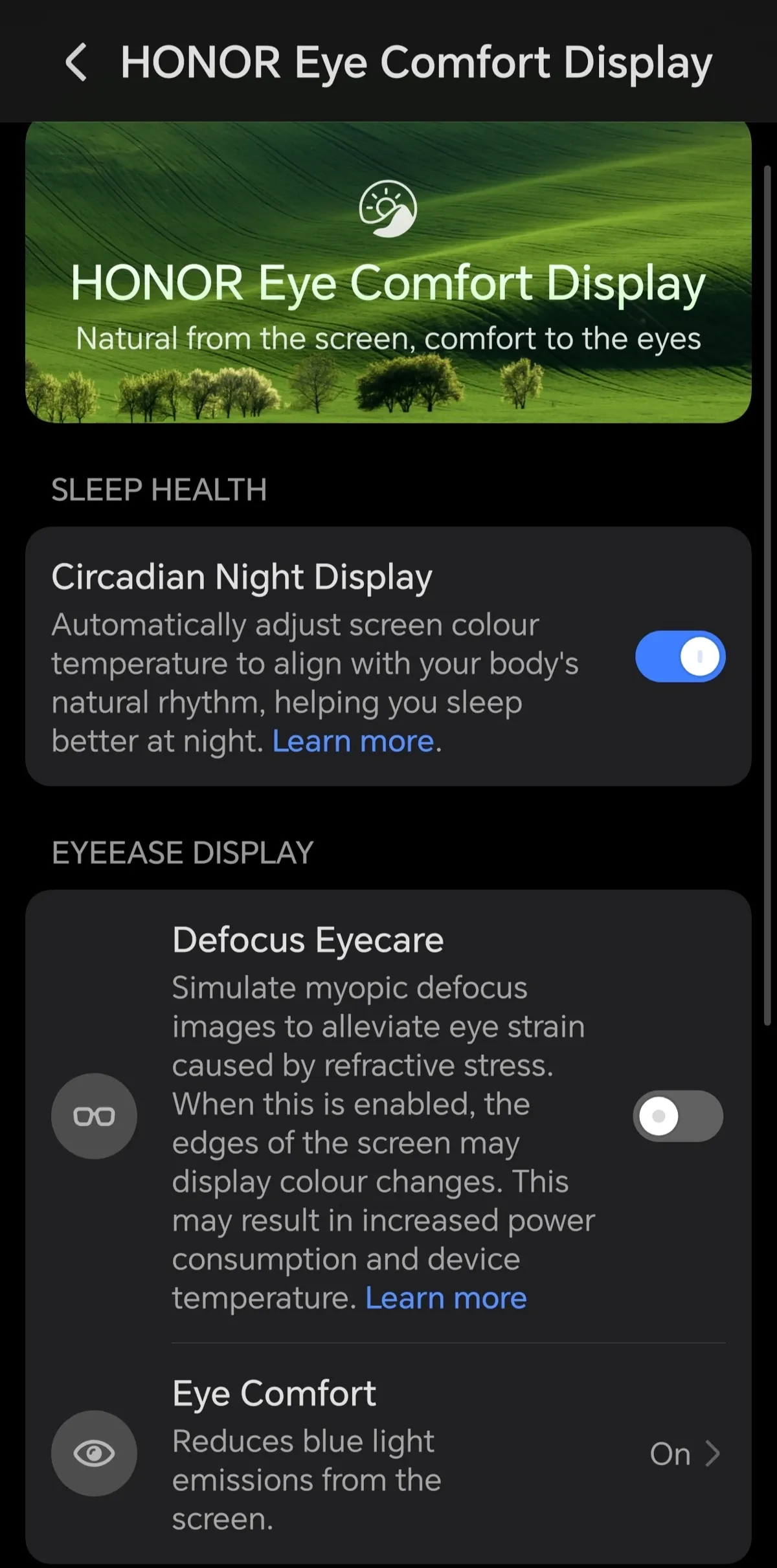
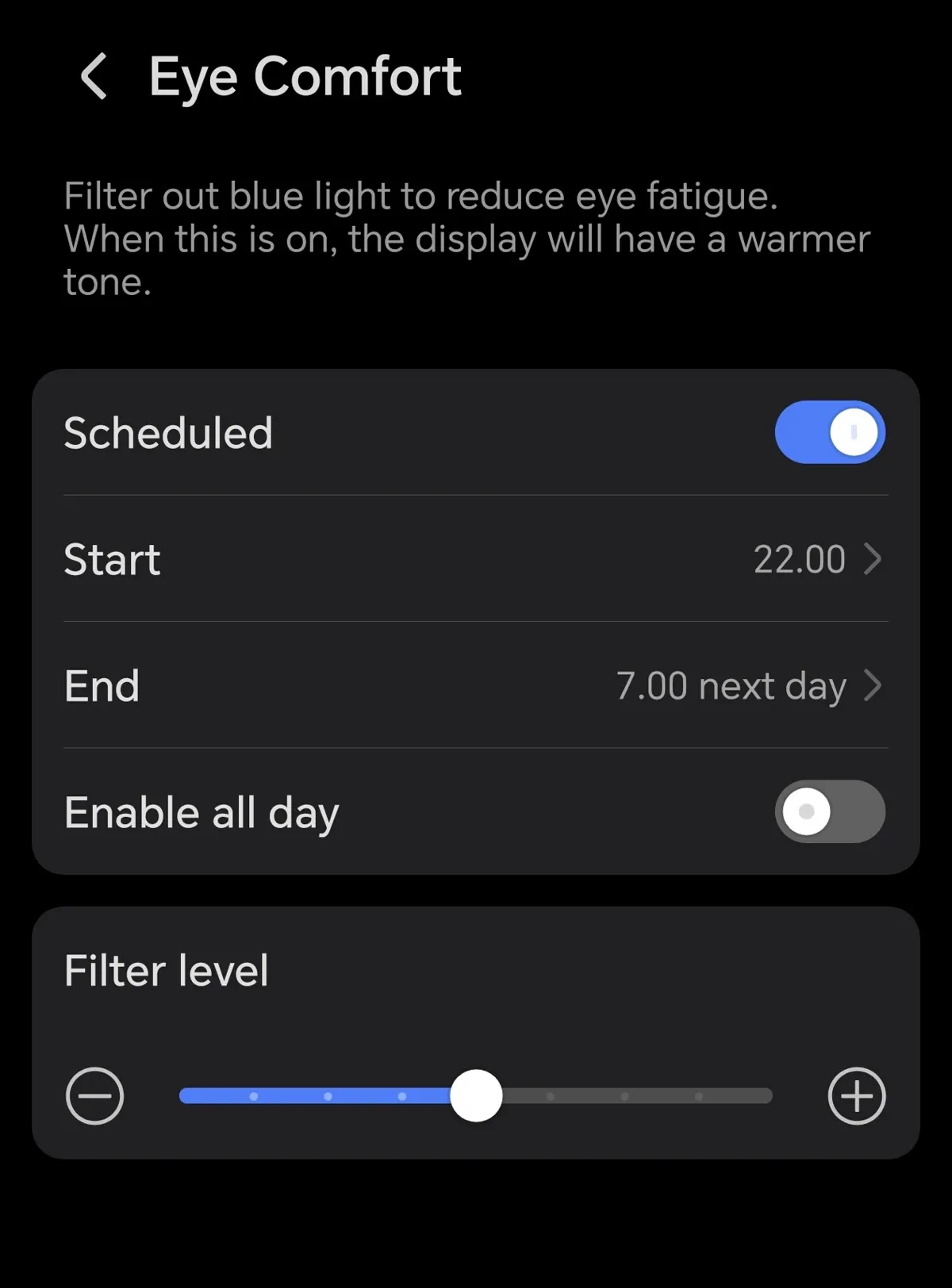
Display accessibility settings are the best you'll find on any device
For optical health and mental wellbeing, I've yet to find a device that has felt as comprehensive or inclusive as this one.
Battery life
While mostly acceptable, the battery on the Honor 400 falls slightly short of the competition. It's not bad, but it you can see where it could be just a little bit better. Which is weird, because the 5300mAh silicon-carbon battery is technically extremely impressive. Perhaps it's just some software hiccups that cause unexpected strain.
You'll get a full day out of normal to moderate use, meaning web browsing, emails, social media and the like, just as long as you don't go crazy with it. Instagram and YouTube, for example, drain the device like crazy. I used the Honor 400 on my flight from Helsinki to London to catch up on Sakamoto Days on Netflix, and found that just over two hours of streaming cost me almost 25% of battery.
As for charging, well, the Honor 400 is squarely in the "just enough" bracket. It's nowhere near as fast the OnePlus 13r or some Huawei rivals, but the 66W charging speed gets you from 0% to 100% in just under an hour. Granted, this means you have to buy a special Honor SuperCharge brick for it, as Honor does not pack a charger in the box, nor does the Honor 400 support wireless charging.
That said, Honor does claim the silicon-carbon technology is good for 1200 charge and discharge cycles before you even have to worry about considering changing the battery. If that holds, it means you could charge the phone daily for almost 4 years.
You'll get a full day out of normal to moderate use, meaning web browsing, emails, social media and the like, just as long as you don't go crazy with it.
Software and OS
The everyday experience on the software side of things is simple and effective. Honor has made huge strides with Magic OS, moving closer to a stock Android experience over the years. While their mentality is still all about throwing in everything but the kitchen sink, it's surprisingly streamlined and usable.
For example, the Control Center is as packed or sparse as you want it to be. Pretty much every setting can be toggled from there, and I found during my month with the device that it became second nature to quickly flip things from there instead of finding it elsewhere.
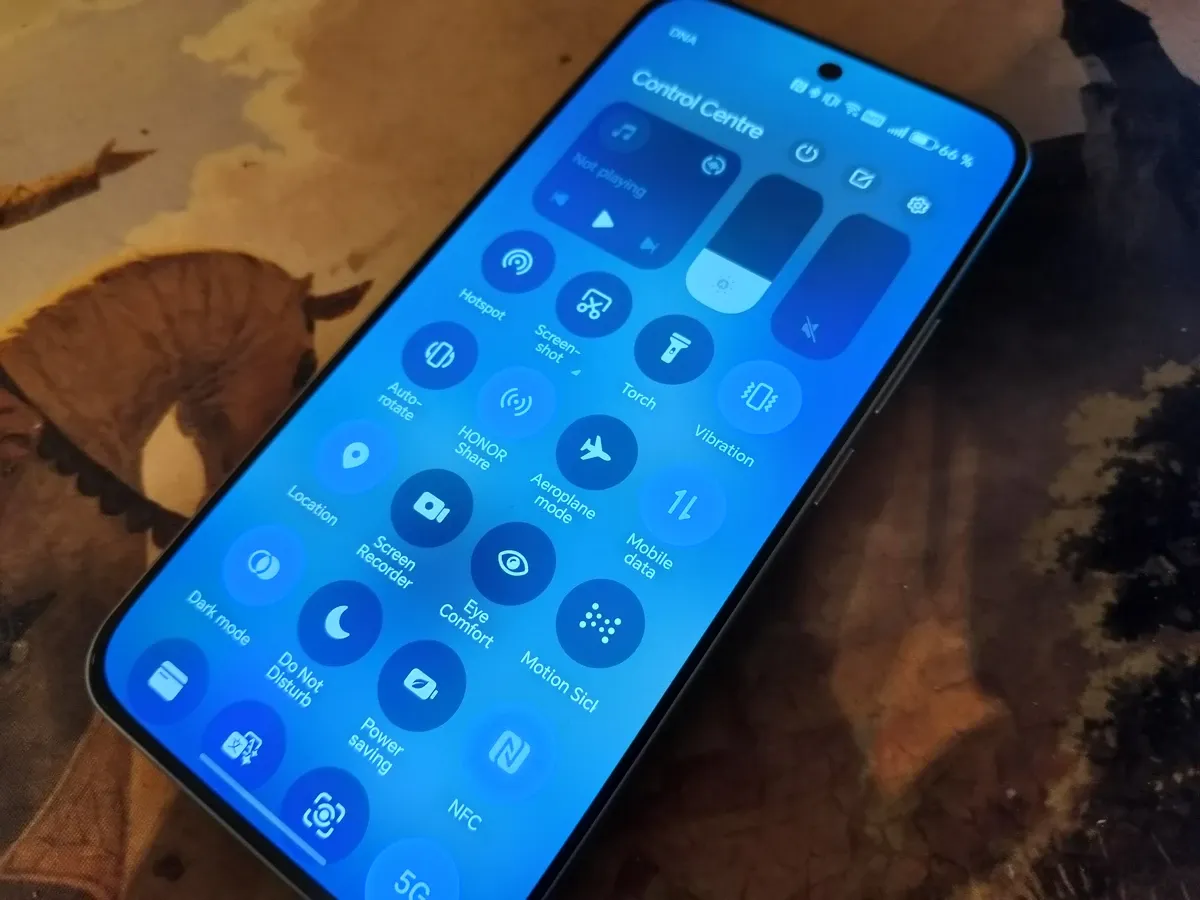
Similarly, Honor's sharing options are some of the best around – even if you're mixing and matching devices.
My main laptop is still a MacBook, and usually pairing an Android device with it has been a pain. Not so here, as Honor's software solutions are extremely easy and accessible for sharing files and photos quickly. Over the years I've wanted nothing more than a solid version of AirDrop for Android, and I think Honor has finally delivered it.
Granted, Honor still places an emphasis on its own ecosystem. Before my review period, I had picked up an Honor Watch 2 from an outlet sale on a whim, and noticed pretty quickly how seamlessly it paired with the phone. I can only imagine that going fully in with their devices, like their MagicBook laptops, will yield even better results.
Everywhere else, the first party software was a joy to use. Honor has clearly taken hefty inspiration from Samsung and Apple here, but you can't argue with results. For my work, I use the Notes and Recorder apps daily, especially for interviews at festivals. During the review period, I gave both some truly difficult circumstances to handle, and they did not let me down.
For example, the Recorder app not only captured an interview with fantastic clarity in an extremely loud environment (complete with a DJ blasting away in the background), the AI system transcribed the conversation with enough accuracy that it saved me at least two hours of work when I got back to the hotel. For content creators and especially writers, this kind of ease of use is invaluable.
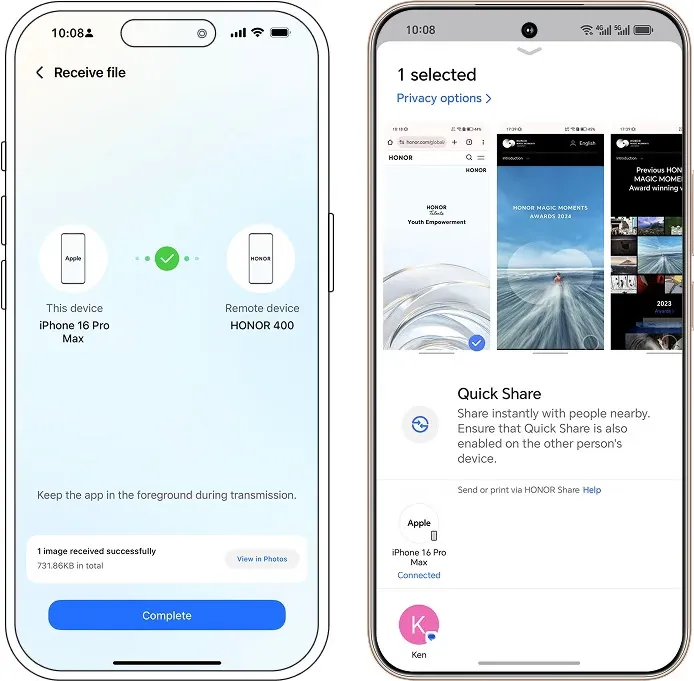
Honor's software solutions are extremely easy and accessible for sharing files and photos quickly. Over the years I've wanted nothing more than a solid version of AirDrop for Android, and I think Honor has finally delivered it.
The camera
In everyday use, the Honor 400 camera hits all demands I place on a daily driver. It is reliable, you can point and shoot and not worry about the result, and the camera is (mostly) snappy enough to capture spontaneous moments.
On paper, the specs are quite impressive.
In daylight, the Honor 400 produces bright, colorful, and sharp images. It especially stands out in landscapes and people, especially if you get them to pose for some of the glamour shots and AI filters that Honor packs into the device. If you're one who likes to take selfies or glam shots of friends, the Honor 400 is the phone for you.
For me, I found myself nine times out of ten to be happy with what I got. On very rare occasions I did notice the Honor 400 producing blurry shots, especially with fast moving pets, but those are only memorable because of how few times it happened.
Most of the time, I didn't have to think about my photos. Which means that I could take out my phone, grab a shot, and I knew it was a keeper. Even zoom images turned out great for their intended purposes.
I tested out the Honor 400 at Ropecon's annual cosplay event, and by the time I got to the venue, there was only standing room at the very back in a dimly lit room with harsh backlight. Imagine my surprise when the 20 to 30x zoom photos turned out just fine for social media sharing!
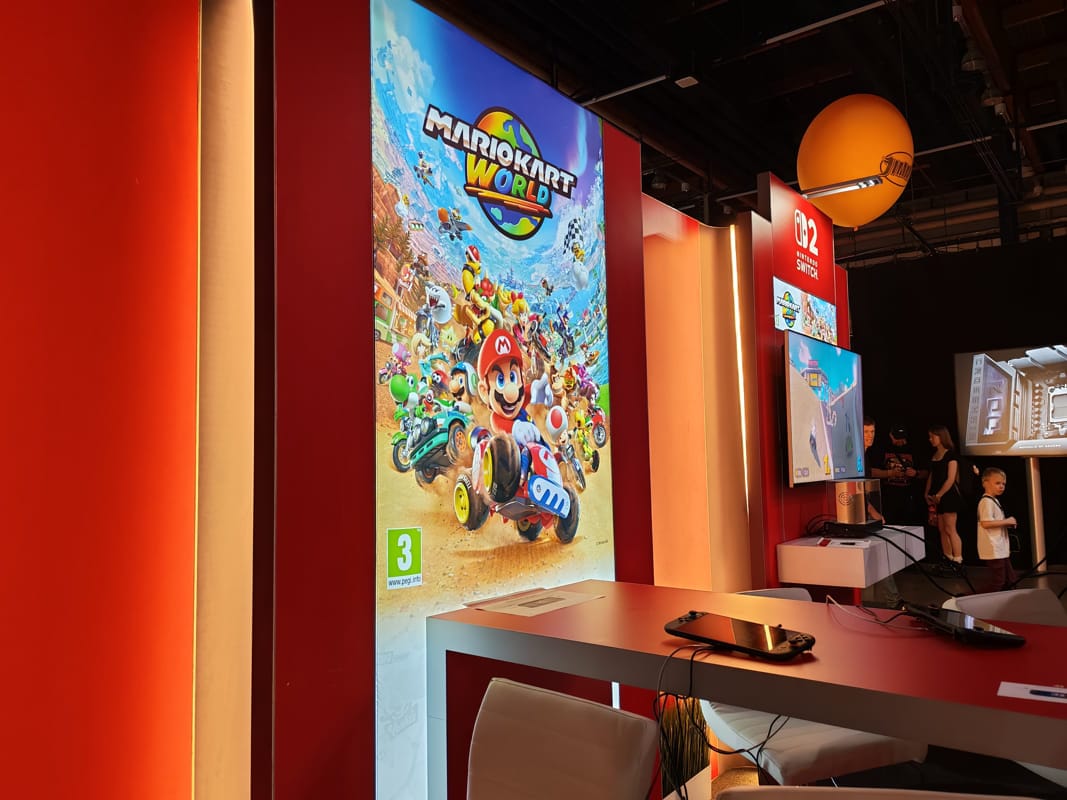








The Honor 400 delivers quality pictures in almost every situation
If you're one who likes to take selfies or glam shots of friends, the Honor 400 is the phone for you.
Selfies and macros
The selfie camera on the Honor 400 is, just like the portrait camera, exceptional for the price. Portrait photos come out crisp and clean, with great, natural-looking bokeh, while preserving fine detail like hair. There is an option to use AI enhancements on the photos, or even go wild with beautification settings, but I would rather just use the unedited pictures.
Macro photography isn't a strength here, though you can get completely useable and often pretty photos from close-ups. But this is clearly a camera that excels with people, not objects. That said, I took plenty of pictures of miniatures, LEGO, and other art during my time with the Honor 400, and I rarely felt like I had missed a shot when going over the results.




Selfies and macro photography are both reliable and consistently good
Video quality
Video quality is all around good to excellent, though with a few more compromises than photography.
Firstly, I noticed that when recording in 4K, the software would stutter for the first couple of seconds every time I started to film. I couldn't replicate the stutter during long sessions, which means that it's probably a case of the device having issues with memory. 4K is also restricted entirely to 30fps, if you want to record at 60fps, the resolution dips to 1080p. For most, this is a completely fine compromise, but it is a bit of a bummer all things considered.
Once the video got going, however, I was happily surprised by the quality. In daylight, the Honor 400 produces vibrant and sharp footage that I could happily use in content creation. The camera is quick to focus, and I found the AI auto detection was consistent, with rarely cases where it would lose track of the subject.
I particularly found the video footage to be terrific when capturing daily life in the city or grabbing some quick B-roll for my Vlogs. Even when walking briskly and moving the camera horizontally, the Honor 400 kept up admirably without artefacting or causing blurriness to signs or people.
The selfie camera was OK in terms of video quality, and even captured some decent footage in extremely difficult situations. In the samples below, you can see that while it struggles a bit to keep up, bear in mind that this was in a badly lit environment with a harsh sunlight glare behind me and hundreds of LED light sources from computers on at the same time.
All things considered, that's seriously impressive for any phone, let alone one at this price point.
Video samples from the Honor 400 main and selfie cameras
At night and in difficult lighting conditions, such as the one below, the Honor 400 almost consistently blew me away with impeccable contrast and gorgeous detail. Before using it, I was certain that it would not keep up during my time at Ropecon, where I wanted to video the costume show from the very back of the room. Instead, it lived up to every expectation and beyond.
Options are once again resplendent, with enough AI-focused trickery to allow for quick snaps and videos that will look just fine for social media purposes. The pro-tools, on the other hand, are robust, but a bit fiddly, and I found them to be less useful than I had hoped. Granted, I kept comparing them to more expensive cameras constantly, which just speaks to how high the Honor 400 punches. This is not a camera you compare to other budget phones – it's a device you can easily put next to a thousand Euro competitor and feel completely confident in what you've got.
Video, both regular and zoomed, proved great even in demanding lighting
This is not a camera you compare to other budget phones – it's a device you can easily put next to a thousand Euro competitor and feel completely confident in what you've got.
The compromises and negatives
Oddly, my review unit would heat up at weird times, often when it was just in my pocket. Even after some bug hunting and resetting, the problem remained. I asked around from colleagues, and this seems to be a relatively common issue. I didn't notice it causing issues with the battery life, but it is worth noting. Sometimes, the Honor 400 just gets a bit toasty.
The European model that I tested also only comes with 8GB of RAM (though Honor claims an extra 8GB through software trickery). While everyday use was mostly fine, I did notice programs closing down in the background far more often than with other devices with even 4GB more RAM.
Occasional software hiccups caused annoyances, too. Sometimes, the Honor 400 would hang while switching apps, or loading a website after longer sessions of doomscrolling. The camera app, as mentioned before, would always take a few seconds to actually boot up. The Honor 400 comes equipped with a Qualcomm Snapdragon 7 Gen 3, which is a fine mid-tier processor, though it's starting to show its limits.
None of these were issues that made me dislike the phone, but they were noticeable and prevalent enough that they warrant mentioning. It is only here the Honor 400 reminds us that it's a mid-range device, and I think it says more about what a high bar it sets from the outset that something as minor as this feels noticeable. After all, this is a device that I edited 4K video with on the fly. That's not nothing!
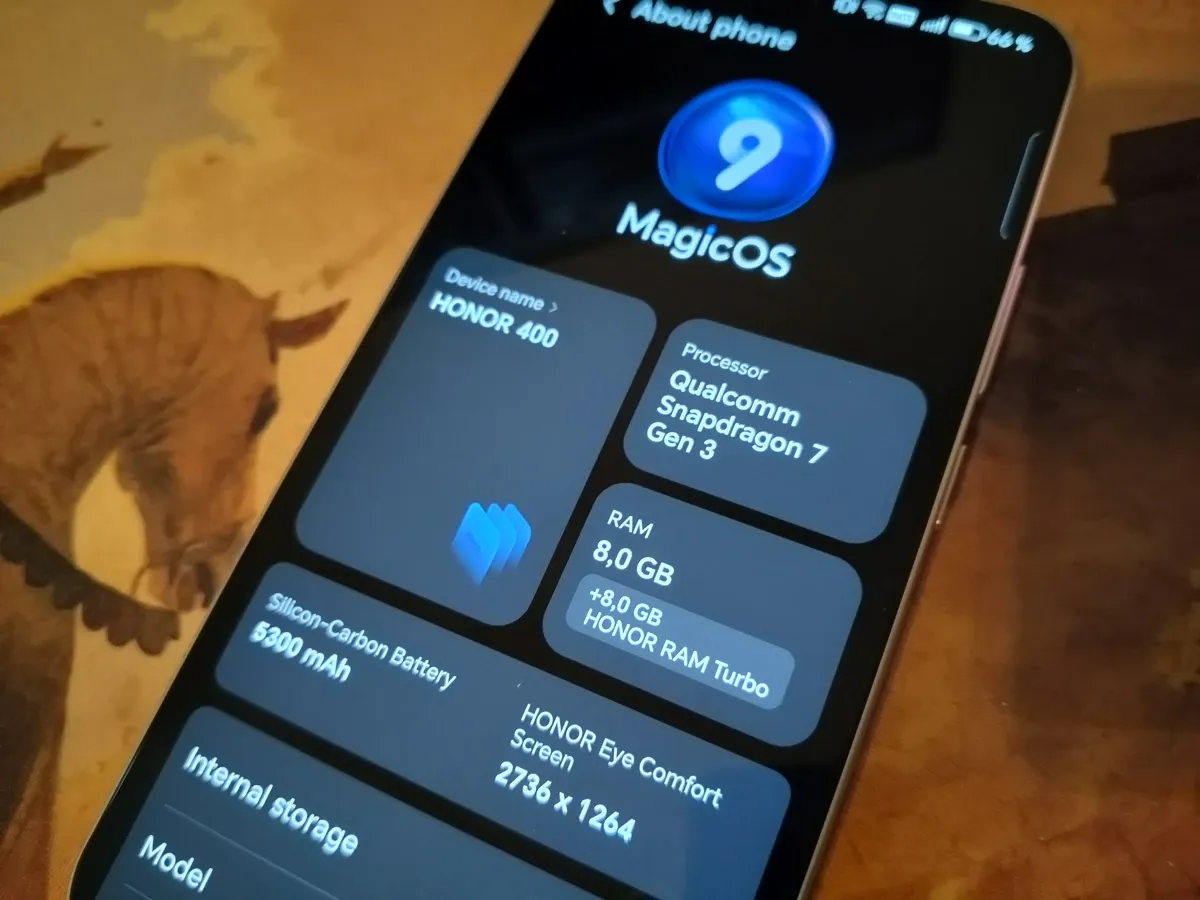
Gaming
For gamers, Honor 400 proves to be a little harder to recommend. Some games, like Diablo Eternal, work just fine on medium settings. Others, more demanding titles, like Wuthering Waves, barely work on anything but the lowest settings, and even then struggle to maintain solid frame rates without stuttering.
I tested the Honor 400 with another review device, the Razer Kishi V3, and found gaming on it mostly pleasant, though not my go-to device on the road. Something like Balatro was about as demanding as I'd throw at it, especially if battery life was a concern. If gaming is your major want from your mobile device, I would recommend looking elsewhere in the Honor series, like the Magic Pro lineup, which fares considerably better.

Accessibility and AI
The Honor 400 is packed to the brim with AI features, both useful and questionable in their inclusion.
The best ones are similar to what you'll find in other devices, though their integration to first-party software is as good as you'll find on Apple or Samsung.
For example, one of my favorite features is the three-fingered swipe down on any screen, which saves the entire webpage you're currently reading into a favorites space. There, you can return to it at your leisure and even find a full AI summary for a recap later.
You don't need any other apps for it to work. It just happens instantly on your phone, and it's the kind of tremendous ease that I would want out of anything I use. For me, if the phone has to have AI or anything like it, I want it to work so that I don't even notice it's there.
Other features, like the AI Eraser or cutout tool, are the same as elsewhere. I rarely use them, but I can easily find use cases for both. Especially as they work fast and have gotten better over time. The cutout tool, for example, works with the kind of black magic that I can't even comprehend.
The AI Eraser, for its part, does a great job of computing what to replace things with, and even works surprisingly well when I tried to trick it by using 2D background art a launch event. After thinking about it for a few seconds, the AI Eraser did its job as faultlessly as instructed.
That's seriously impressive.


For photography, the AI tools extend to basically every aspect of the experience, to the point that like many others, I too wonder what even constitutes as a photo anymore.
One of the newer inclusions for me is the AI Outpainting mode, which imagines what the expanded view of any location would look like. Here, you pick how far out of the frame you want the AI to generate new context, and it provides an amalgamation of everything it thinks should go there.
In the picture below, I asked it to expand around 150% further, which it did to the point that if I shared this on social media, I doubt anyone would guess it wasn't the real thing.
That's both a good and bad thing, as I'm just on the cusp of being old enough to find all of this scary. I know that the picture on the right isn't real, and I can tell the books past The World of Tolkien are fake and there isn't a plant or a weird doll on my shelf – but if I gave this photo to my mom, she wouldn't think twice about its validity.
In short, it's all very impressive, and I fear for the future.


The AI outpainting function imagines a new world around you.
Verdict
When writing this review, I started to wonder how many times I used the words "surprised" and "impressed". Turns out, it's quite a few.
But that's precisely the Honor 400 in a nutshell, a surprisingly impressive device that has continuously kept me on my toes. When it arrived for testing, I figured I would at least find it a passable, if not particularly noteworthy.
A month later, I wouldn't be sad if it was my daily driver. It delivers on every aspect I want out of my phone. Yes, there are compromises, and I wish it had better battery life and more RAM, but I'm more than willing to live with those issues when everything else works so well.
Most importantly, the Honor 400 achieves the one thing a smartphone should: It made me imagine a life in this particular ecosystem, and I'm finding it hard to find reasons against the idea.
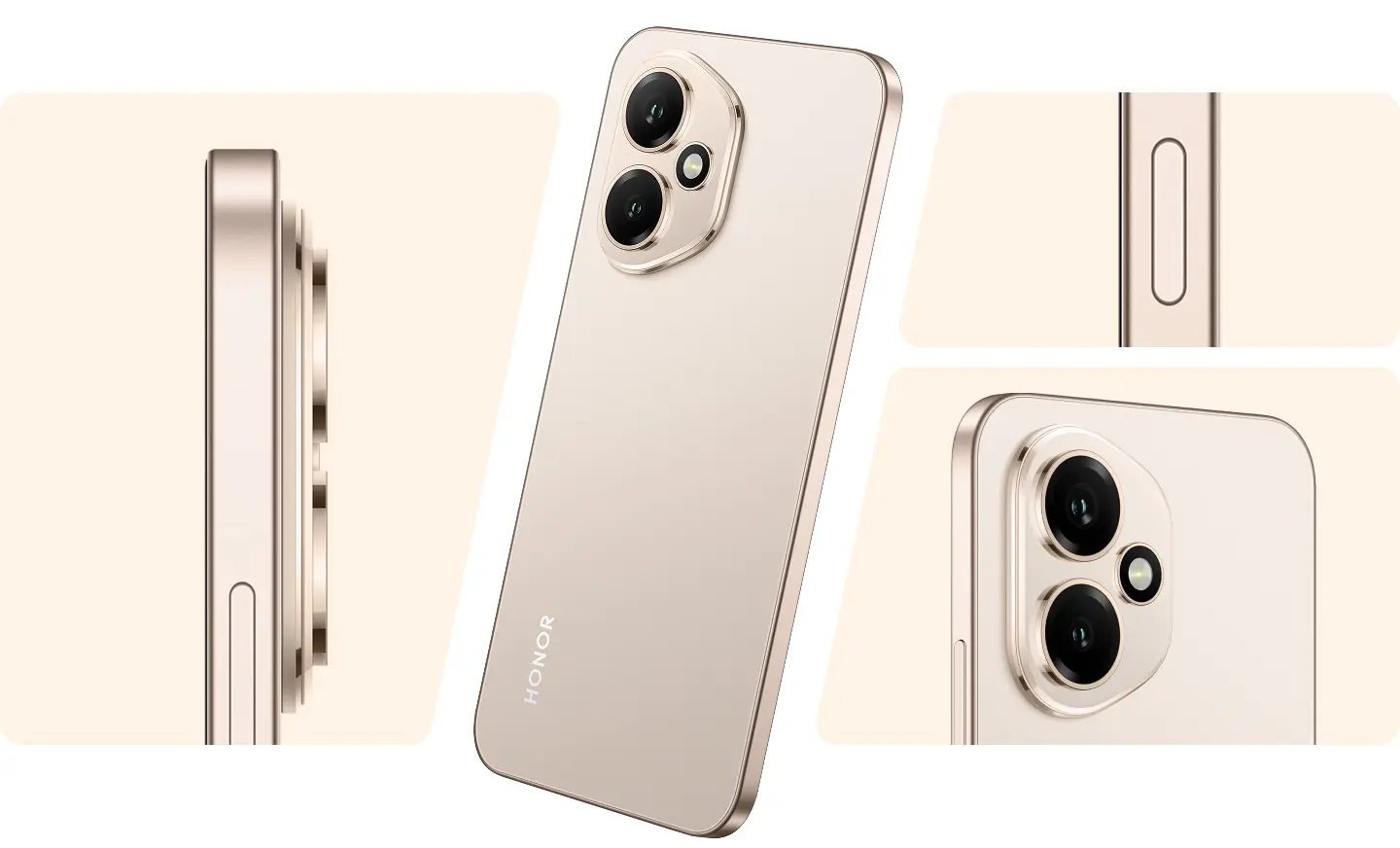
Final word: Honor 400
Even with some compromises, the Honor 400 is a stellar mid-range phone that provides so much value that it's hard to find many faults in it. This is an all-around great device for daily use, one that should prove exceptional for those who want a reliable device that's good -- if not exceptional -- at everything you need.
Review disclaimers
If you want to read more about my reviews policy and transparency, you can do so here: https://toisto.net/how-i-review/










